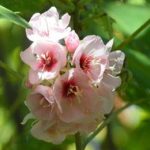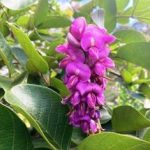TREE LIFE
August 2021
We are still in the grips of the Covid pandemic and so we have neither Coming Events nor Past Events to comment on. This is a sad time for the Tree Society, as it is for the whole country, and we can only hope to keep up the interest with the Tree Life. We are grateful to Ryan Truscott for faithfully providing articles filled with interesting titbits.
Whilst we are on a rather gloomy subject, and we have heard about it many times, we are desperate for a new Editor and someone who can keep the Web Site uploaded and up to date. This is not a hugely time consuming operation. I spend a couple of days a month operating asI am now. As you know I recently suffered a stroke, and if anything happens to me the load will become impossible for Tony, and if anything happens to Tony!!! And so, if you wish to continue getting Tree Life as it is, it has been going for 71 years, and it would be a pity to let it die now, with the Covid, please contact me and I can go through it with you.
SAVING A LIVING FOSSIL TREE IN MALAWI
This month we will take a trip north to the place Malawians call “the island in the sky” — Mt Mulanje.
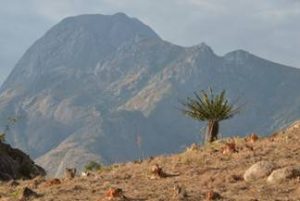
The cycads grow at heights of up to 1,000 metres on Mt Mulanje — Pic Credit: Carl Bruessow
A team of conservationists there is working to save a tree that botanists refer to as “a living fossil” — the Mt Mulanje cycad, Encephalartos gratus.
My 1977 edition of Trees of Southern Africa describes cycads as members of a “slowly dying group”, but the Mt Mulanje cycads are alive and worth saving.
That’s according to one of the trees’ chief protectors, Carl Bruessow. “I think cyads are resilient. It’s human beings who’ve been around with them,” Carl says.
He and his team from the Mulanje Mountain Conservation Trust (MMCT), supported by the Mahomed bin Zayed Species Conservation Fund, are working to produce 50,000 seedlings of the Mt Mulanje cycad. When I spoke to him, he had just delivered 10,000 seeds to a partner organisation.
Once the seedlings or “pups” are established, they will be planted out at selected sites around the mountain.
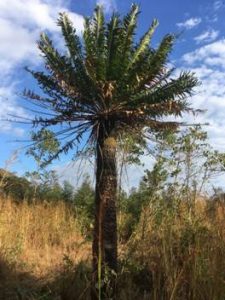
The Mt Mulanje cycad is deemed vulnerable to extinction — Pic Credit: Carl Bruessow
The Mt Mulanje cycad, with its thick trunk and palm-like leaves, only grows at a maximum altitude of around 1,000 metres. The highest point on the massif is more than 3,000 metres.
Carl said he’s noticed that white-necked ravens descend from higher elevations to feed on the pulp of the seeds, which are borne on large orange cones.
The Mt Mulanje cycad is deemed vulnerable to extinction — Pic Credit: Carl Bruessow
But the ravens evidently aren’t effective at seed dispersal. The International Union for Conservation of Nature lists the Mt Mulanje cycad as vulnerable to extinction because of its declining numbers in the wild.
Cycads are among the most trafficked plant species on the planet. That’s partly to do with their novelty factor. People like the idea of having a plant in their garden that was around during the time of the dinosaurs.
But the main threats to the Mt Mulanje cycad have been human population growth and habitat destruction, explains Carl.
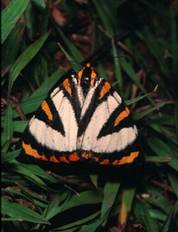
The Mulanje tiger moth has developed a unique relationship with the cycad — Pic Credit — Julian Bayliss
It’s not just the cycad that this project aims to preserve. The lives of two other unique species are entwined with it: a weevil responsible for its pollination and the strikingly beautiful Mulanje tiger moth, Callioratis grandis.
The moth is also a living fossil, says Julian Bayliss, who isn’t involved with the project but previously spent six years working as an ecologist for the MMCT.
He says the moth’s caterpillar feeds on the cycad’s toxic leaves. This makes them poisonous to predators like birds, allowing the moths to fly around confidently in the daytime.
Julian says it would have taken millions of years for the moth to develop this unique relationship with the cycad. The male tiger moths engage in “lekking” — competitive group courtship displays. These displays are normally only seen among birds and mammals. Julian told me the moth is critically endangered, with fewer than 2,000 individuals estimated to be left.
In the past many were destroyed when land was cleared to make room for tea plantations, though many of the houses on tea estates are now a valuable source of seeds for the project. The have the cycads growing in their gardens.
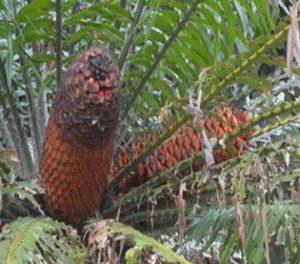
Each cycad cone produces hundreds of seeds –
Pic Credit — Carl Bruessow
Mt Mulanje is a biodiversity hotspot that is home to unique plants, including 50 that are strict endemics — found only on the massif and nowhere else. Two more new to science were described in March in the journal Kew Bulletin. They are both small shrubs: Isoglossa perdita and Agelanthus patelii
The Mt Mulanje cycad, however, is not strictly endemic. Its range extends to a hillside above the town of Milanje, just across the border in Mozambique.
Carl says as soon as Covid-19 travel restrictions are lifted, the team plans to go over to plant seedlings there too.
-Ryan Truscott
THE SHRUB COMMUNITY OF THE KALAHARE SANDS
A ROOTNOTE by Kim Damstra in TREE LIFE No.47 (January 1984) provides some insight into the value of the shrub community of the Kalahari-sand forests of northwestern Matabeleland:
John Rushworth, of the Department of Biological Sciences at the University of Zimbabwe, displayed some results recently that I thought bear repeating. He has been working in the Kalahari sands of Hwange National Park. “Large areas of deep, infertile Kalahari sand in western Zimbabwe are carpeted with a dense, woody, shrub community, one to four metres tall, and are often regarded as of little use to man or the larger herbivores.” As the name implies, the Kalahari sands consist of coarse particles. In fact, only about 2% is silt or clay. A rich soil of volcanic origin, also within the National Park is known as basalt vertisol, and contains 91% silt and clay. This difference is important because many nutrients that are washed away in sand will cling to the tiny clay particles, and therefore will be available to the plants. To sidetrack for a while, this is one reason why termitaria are often so rich in nutrients. The termites collect all the silt and clay from the surrounding area, and pack it into their nest. This helps change the nutrient status so dramatically that we cannot fail to notice the difference between the vegetation on the termitarium and off it. To get back to the Kalahari sands, they do have a low level of nutrients. But coarse sand does have an advantage – we usually use a high proportion of sand in seed trays to encourage rooting. Kalahari sand is an excellent rooting medium. Many trees develop an extensive root system in the 30-m-deep sands. The rain water is quickly absorbed into the sand, where it is available to the roots. Many of the trees are legumes, such as Baphia massaiensis subsp obovata [jasmine pea], Acacia fleckii [blade thorn], and Baikiaea plurijuga [Zambezi teak], and can increase the nutrient status by means of nitrogen-fixing bacteria in their roots. Other Kalahari-sand plants, besides these, can also fix nitrogen. Dr Rushworth investigated the availability of food to animals during various times of the year, especially by comparing grasses and woody shrubs. He found that at the height of the dry season, before the rains, the deep-rooted trees flushed out in new growth that had a moisture content of 68%, compared with the grass water content of 20%. There was also much more browse available. The crude protein of the perennial grasses at this time of the year ranged from 4% to 6%, whereas in the shrubs it ranged from 19% to 26% – rather significant. The one exception was Lonchocarpus nelsii[Kalahari apple-leaf], which had 39% crude protein in the leaves in September. “Of the plants listed, Terminalia sericea[silver terminalia] and Baikiaea plurijuga [Zambezi teak] are not as favoured by the wild herbivore browsers (including elephant, giraffe, eland, kudu, impala, steenbok, and duiker) as are the remaining species (Baphia massaiensis, Bauhinia petersiana subsp serpae, Combretum collinum, Pterocarpus angolensis, Combretum zeyheri, Lonchocarpus nelsii, and Ochna pulchra). Bearing in mind the high quality of this leaf material, a good stock of valuable food is available in this shrub community, particularly during the dry August-November period when the grass layer is low in both quality and quantity.” John goes on to conclude: “The high quality of woody-shrub leaf material produced under arid conditions on infertile Kalahari sands in western Zimbabwe is nothing short of remarkable. Many wild herbivores, particularly the browsers, thrive on this source of high-quality food available in large areas of the Kalahari-sand region of Hwange National Park. Provision of permanent water supplies is often the only management aid required. It is apparent that there are vast untapped stores of valuable food available in the leaves of many woody shrubs of the `bushy/scrubby’ areas of Zimbabwe for both domestic and wild herbivores. Simple management practices can make much of this food energy available, particularly during the critical, dry, August-November period when natural grass stocks are low in both bulk and quality. The discovery that two apparently “useless grazing grasses” (Eragrostis spp) play a role in vital atmospheric-nitrogen fixation must surely make one more hesitant in the future to arbitrarily proclaim that any particular plant is of no use. We often know so very little about the life histories and real value of our indigenous plants. The woody species of the Kalahari-sand shrub community appear to represent equilibrium species, expending energy in the building up of massive underground rootstocks or other storage organs, which give the advantage in long-term survival. This particular ecosystem is markedly resilient to above-ground damage, and it represents both a very stable and valuable resource”. Quotations from Rushworth, J.E. (1978). Wankie National Park Notes No.20: 8 pp.
[Comment 2000: Bauhinia petersiana subsp serpae has been renamed B. petersianasubsp macrantha.
PAPER AND PAPERMAKING
(Adapted from an information sheet produced by Hunyani Paper & Packaging (Pvt) Ltd)
History
According to tradition paper was first made in China in 105 AD by Ts’ai Lun, a courtier of the Emperor. Formerly people wrote on strips of wood, or silk, or on papyrus bark, but from that date Chinese history and records were written on scrolls of paper. The earliest paper that still exists was made from rags, and dates back to 150 AD. Paper from China arrived in Egypt at the end of the 8th century, and from there the Moors introduced it into Europe. Printing was also invented in China, spreading to the rest of the Orient in the 9th century, and thence to Europe. This ability to produce multiple copies of the written word, graphics, and pictures in a mechanical way was – and still is – an important reason for the continuing high demand for paper.
Paper-making Materials
Paper comes from vegetable materials, which contain cellulose fibres in their structures. These are first reduced by chemical and mechanical energy into their component fibres in a process called `pulping’. Wood is the most common material used for making paper, but sisal, hemp, bagasse, and even wheat and maize stalks will do.
In Zimbabwe we use four different types of material for making paper. At the Hunyani Mill at Norton the wood of eucalypts is the main material for pulping, along with a smaller amount of wood from pines. Chips of these woods are heated to high temperatures in mixture with sodium sulphite, and `refining’ or mechanical energy is then applied, producing a `semi-chemical’ pulp. Eucalypt pulp is ideal for making fluting, the very stiff centre ply of a corrugated cardboard box.
At Kadoma Fine Papers cotton linters (a waste product from cotton processing) are heated with caustic soda, followed by bleaching with peroxide, to give a fine cotton pulp to be transformed into a very desirable white printing and writing paper.
At Mutare Board & Paper Mills debarked pine logs are processed by pressing them against rotating grindstones in the presence of hot water. This process consumes a lot of energy, and produces `groundwood’ pulp, which has excellent properties for making newsprint and folding boxboard.
The Kadoma Tissue Mill, and the mills at Mutare and Norton, also use large amounts of recycled paper as important parts of the various grades of their paper products. The waste paper is collected throughout Zimbabwe, sorted into different qualities, and distributed to the mills.
Papermaking
The pulp fibres are well mixed with water, and the suspension of pulp is filtered through a fine sieve or screen, leaving the fibres in the form of a sheet. In earlier times paper was made by hand in sheets, using rectangular sieves, but in 1803, in England, the Fourdrinier brothers developed a commercial paper machine from the design of a French inventor, Nicolas-Louis Robert, of a continuous machine using an endless wire mesh. The same type of maching is still widely used, although the `wire’ mesh has now been replaced by plastic, and modern machines are much faster than that early invention. Indeed, of five of the six papermaking machines in Zimbabwe are `fourdrinier’ machines.
The Uses of Paper
The single largest use for paper is in printing. Newspapers, books, periodicals, brochures, forms, leaflets, labels, duplicating, and computer printout are just some of the many purposes for which paper is printed.
Packaging is also a very large consumer of paper. Corrugated cases, cartons, bags, sacks, and wrappings are important for holding goods, for transporting them safely, and for informing the customer of the contents. Very often the packaging will have attractive printing on it.
Tissue products made from paper and fluffed wood pulp are a growing market worldwide. This creped paper gives us toilet tissue, facial tissue and towels, and a variety of other hygienic products.
It is often said that the consumption of paper is a good indicator of the state of development of a country, and indeed there is a strong relationship between the two. The United States of America, one of the most developed countries, has an annual consumption of 320 kg of paper per head, whereas South Africa consumes 44 kg per head, Zimbabwe 11 kg per head, and our neighbours in Zambia a little over 1 kg per head.
The Environment
The paper industry is well aware that its activities, if not well controlled, could cause damage to the environment. It is thus mindful that, if it is to prosper in the long term, it must foster the sustainability of its resources, and have a genuine care of the environment. There have been numerous cases in the past of pulpmills polluting rivers and water supplies, but today this is most unlikely to happen.
Paper Production in Zimbabwe (1997)
Hunyani Pulp & Paper, Norton – 50 000 tonnes
Mutare Board & Paper Mills – 31 000 tonnes
Kadoma Fine Papers – 8 000 tonnes
Kadoma Tissue Mill – 5 000 tonnes
-Lyn Mullin
The above two articles were taken from Tree Life No. 251
THE GIANT POM POM TREE
The species was named by Linnaeus from a specimen grown in Holland by David van Royen, Professor of Botany at Leyden, and which flowered in 1757 . It is a fascinating fact that he knew the tree in the 1760s when the countryside it came from was virtually unexplored.
EVE PALMER & NORAH PITMAN (1972-73) – TREES OF SOUTHERN AFRICA
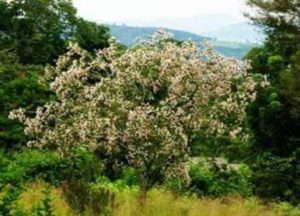
Dais cotinifolia . Photo: Bart Wursten. Source: Flora of Zimbabwe]
It is only quite recently that the pompon tree, Dais cotinifolia (Thymelaeaceae), has become a popular urban ornamental in Zimbabwe, or anywhere in southern Africa, yet it has been cultivated in Europe for more than 200 years. Its natural range is from round East London on the South African coast northwards to the north-eastern Transvaal, with an ex¬tension to the Eastern Highlands of Zimbabwe. Seed was collected in South Africa in about 1749 and sent to Holland, where Professor David van Royen raised it. He called it Dais – torch – because the long-stalked, pink flower heads looked for all the world like torches about to be lit. The great Swedish botanist, Linnaeus (Carl von Linné), adopted van Royen’s generic name for the plant, and he gave it the specific name cotinifolia because of the resemblance of its leaves to those of members of the genus Cotinus (Anacardiaceae).
The pompon tree in Zimbabwe is often no more than a shrub or small tree 3-4 metres tall, occasionally up to 13 metres, but it reaches much larger sizes in the Chimanimani district. On the road from Chimanimani village to Bridal Veil Falls is the “Little Waterfall”, and in the valley about 200 metres below this fall there is a particularly large specimen with five main stems arising from the base. In December 1986 it had a diameter of 84.4 cm at ground level, and the two largest of the five stems had breast-height diameters of 46.3 cm and 36.7 cm respectively. The tree was 21 m tall. Up and down the stream from this tree were others of the species with diameters of 30-40 cm and heights up to 16 metres.
-Lyn Mullin
The above article was taken from Tree Life issue No. 242
CHAIRMAN TONY ALEGRIA


